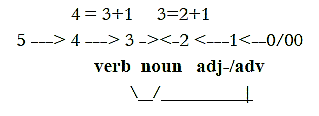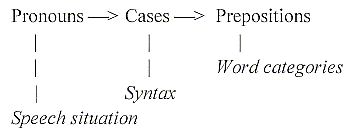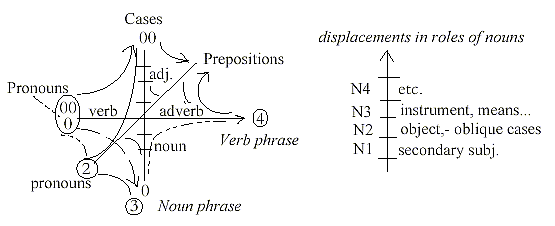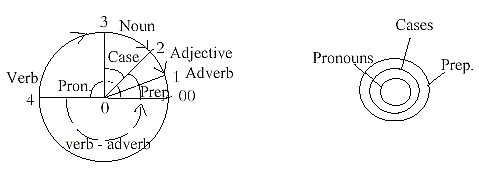|
1. The development from affixes to separate word classes
in languages referred to here seems as a clear illustration
of the main features in the applied model: the debranching
degrees in steps outwards toward lower d-degrees.
In simple terms of our dimension model:
Prepositions are
a) the vector character of d-degree 4 debranched
to a position before nouns in the step 4 →
3, where the verb also transforms to radius, a pole of d-degree
3,
(4 = 1 + 3),
b) the same vector character, debranched to d-degree
1 in the loop model ("the other way around") become
vector-adverbs, closely related to prepositions.
4 → 3 ... +1.
(Through step 1 →
0/00, when verbs become equivalent with Motions, d-degree
0/00, the prepositions express the vector character in our
concepts "motions to and from each other".)
Pronouns may, as proposed before, be regarded as
originating from outer poles 0 and 00 of d-degree 4 of verbs
in the primary speech situation speaker - addressee(s).
In secondary types of sentences they become
"references". In this sense they too reveal
the vector character of "Direction", d-degree
4 in our model. Verb affixes get debranched to secondary
"pro-nouns", replacing nouns as the "circular",
enclosing pole of d-degree 3.
Both pronouns and prepositions appear as quanta
of the binding force in sentences: pronouns expressing relations
in the whole speech situation and displacements in types
of sentences, prepositions expressing the very transformational
relation in word classes V-N, verbs-nouns.
Prepositions could perhaps be compared
with "group-transporting enzymes" on the biochemical
level: prepositions as expressions for the transporting
mechanism itself.
As such they may be compared with lexical
derivations on a superposed level.
"Form-words" or "functional words"
are the linguists' name for this kind of released elements.
A development towards such free form words
has been going on not only in Indo-European languages but
also in other ones. A couple of statements:
Only about 50 % of pronouns were developed
in the daughter languages of Latin in the 12th century.
Etruscan had pronouns but not many traces of prepositions.
Prepositions
1. To sum up they express a) directions, b) positions
and can in application of our dimension model be regarded
as essential elements of d-degree 4 (Directions) and d-degree
3a (Space, "pre-position"): elements which debranched
give prepositions as a separate word class.
They represent the most pure geometrical elements
of word classes. Many of them also with the most obvious
polar character, divided in pairs of opposites as
to - from, in - outside, above - below, over - under…

Prepositions as displacements of elements in higher d-degrees
4 and 3 becomes also expressions for the displacement of
nouns as subjects to nouns of secondary (oblique) and tertiary
roles in the sentences, as to dative, locative, instrumental
function…
Compare for instance "he saw her"
with "he looked on/at her": in first expression
"her" is only linguistically an "object",
in the second expression also semantically more of an object,
a locative or ...
2. Some statements by linguists about origin of prepositions,
probably (?) limited to certain languages as those from
Latin:
a. Case forms are described as derivations from noun stems.
(BC,s)
b. A case form of a noun becomes prepositions, e.g. in Hungarian
benn → bél.*
c. Prepositions have developed from case forms of nouns
and pronouns - and from comparison forms of adjectives and
adverbs.
d. Prepositions may in general be traced back to adverbs.
(BC).
[Cf. that that many Latin adverbs were said to be case forms
of nouns that "have gone astray".]
e. One example: A unit kata (meaning "in the
descension") with adverbial sense, moved to a position
before the noun or before a verb, transforms it to a preposition,
and creates these as a word class (PW).
*b. Compare in this example n and
l with interpretation
of phonemes and their semantic
roles.
Hence, one main statement or proposition here implies that
prepositions first appeared as cases in what we here
have regarded as the secondarily developed dimension chain
within nouns, before they got released to form-words. The
second that prepositions would have their origin in adverbs,
more in agreement with our view on the loop model above.
It's curious that prepositions with an obvious vector meaning
don't seem to have been parts of verbs. In Swedish for instance
the verb tillhöra (belong to) may just as well
be expressed as höra till, the preposition till
(to) separated to position after the verb: 4 →
3 + 1 in terms of d-degrees.
It would imply that most verbs early
were transformed to radii in d-degree 3 in relation to nouns
in roles of subject and objects - according to views on
verbs above. Only in verbs as come - go does the
higher d-degree of speech situation remain.
However, the near connection between many kinds of adverbs
for directions and prepositions reveal such relations
between verbs and prepositions.
The only difference here is that in the
adverbs (the type "vector-adverbs") the direction
is the main topic, while preposition need a following noun
(per definition!), a definite localization, representing
the step 4 → 3 in our terms.
This differences seems as originally connected with the
one between intransitive and transitive verbs,
the step from d-degree 4 unpolarized, "double-direction",
to its polarization, implying transitive verbs:
- the vector-adverbs derived from intransitive
verbs originally,
- the prepositions from transitive
verbs, radii directly connected nouns.
Cf. the difference in the preposition på (=
on) in Swedish: "köra på (stressed)
någon" (= drive into somebody) and "köra
på vägen" (= drive on the road). In
the first phrase "på" belongs to
the verb as "ad-verb" on its way to a preposition,
in the second phrase, unstressed, clearly pointing out a
position as "pre-position".
It was said that case forms of nouns also influenced attached
adjectives, hence perhaps also the comparable "How"-adverbs
(?), so to speak the straight way outwards in the dimension
chain.
It was a third point in the linguists'
statements above that prepositions also would derive from
comparatives of adjectives and adverbs. Why precisely comparatives?
One answer could eventually be that these
comparatives represent steps in gradients towards higher
or lower d-degrees - as in fact the whole dimension chains
in the interpretations here? In a deeper sense the comparatives
may be regarded as derivations (or integrations) as such?

About pronouns it has been assumed that certain
case forms (syllabic ones) originally have been pronouns.
(BC,u).
Together with the statements about propositions
we could get a picture of a trend as this below, with pronouns,
case affixes and prepositions representing first three levels
in the level chain of linguistic analysis:

- Pronouns suggested as derived from the situation of speech
as most underlying level, originally the relation speaker
- addressee and references from there to 3rd parts.
- Cases regarded as expressions for next level, the Syntax,
representing the differentiated geometries between parts
of speech.
- Prepositions more restricted to word classes as verbs
and nouns.

A rough outline of the relations if imagined as 3 crossing
coordinate axes?

Or as angle steps (projected in the plane):

Pronouns
Pronouns are a very differentiated word class, by linguists
divided in a bit different ways.
Here suggestions on how to look at these
different categories of pronouns in agreement with the dimension
chain:
(5) → 4
Demonstrative <—>
Interrogative:
- These types seem directly dependent on the situation of
speech, connected with directions of the whole sentence.
Demonstratives have a typical vector character of d-degree
4 and simultaneously define a centre, as in first place
a 0-pole.
- The interrogatives represent the undefined anticentre,
the 0-pole, and also inward direction of sentences in opposition
to statements as outwards, marking the "definitive".
The pointing out versus questioning becomes related to moods
of verbs.
(English has two demonstrative pronouns, this and that.
Eskimo has about 30 such demonstrative pronouns (!). (CEL).
(30 = sum of poles in a dimension chain.)
4 → 3:
Personal: nominative, accusative, dative... :
- Personal pronouns in nominative as he, she, are believed
to originate from demonstrative pronouns, if so from the
preceding step above.
(1st and 2nd person are here regarded
as related to first poles in the situation of speech (0
— 00), speaker - addressee.)
The angle change to describing sentences
and subject - object relations implies also a displacement
of personal pronouns to secondary relations as objects,
accusative and dative forms...
The fact that these steps to object, dative
etc. include vowel changes in the word stems of our IE-languages,
indicates their very central function (of high degree) in
speech and their close relations to verbs that have the
same change.
With verbs originally characterized by
d-degree 4, as vectors, it's logical that verb endings developed
to separate pronouns (in Latin) preceding the word class
nouns of d-degree 3 as "pro-nouns".
4a —>3 <—4b:
Reflexive pronouns (yourself, oneself) may
be compared with secondary forms of personal pronouns
in e. g. accusative or dative but refer back to the subject
itself.
They may be related to the polarization
of verbs into active - passive forms (poles 4b = outward
direction, pole 4a = inward direction).
About Swedish, it's said that the s as
in the passive verb suffix, e.g. kallas (= is called)
has developed from the reflexive pronoun sig (= himself,
herself...).
There is the clear difference between
kallar sig (he calls himself) and kallas
(is called): In the reflexive pronoun he is the Subject,
while he in the passive verb form is only, in reality,
an object. Hence, the development from reflexive pronouns
to passive verbs agrees with the displacement Subject →
Object of nouns and pronouns.
The reflexive pronoun sig originates
in its turn from words for self or own, words
for the "I" that has been certified and confirmed,
substantiated. Cf. possessive pronouns in next step.
To reflexive pronouns the reciprocal
may be added, as each other, a dual or plural version.
3 — 2:
Possessive pronouns as mine, his, theirs,
implies a referring inwards, the owner at his anticentre,
at the surface of what is possessed, the real noun or topic
as enclosed within. (Cf. about the auxiliary verb "have"
in the verb-file..
Possessive pronouns originate from case
forms of "reflexive verbs", that's passive
verb forms, so it's said about Swedish (SEO). They
are also expressed through the verb ending -s in
Swedish, the same as in passive verbs.
We should thus observe that the owner
in fact becomes displaced as to the role of an object at
anticentre semantically, while that which is owned has raised
to the Subject, more or less owing its owner. A turn in
the relation in this middle step 3–2 when regarded in the loop model.
3 —> ↑
< — 2: Subordinate
clauses:
Relative pronouns as "which", refer forwards
(or "upwards") to something coming, introduces
subordinate clauses.
It has been proposed above that subordinate
clauses could be regarded as level developments in step
3 → ← 2 through the opposite directions in the loop model of a
dimension chain. These clauses (more or less elliptic) make
something mentioned to a new start as subject, a centre.
All the mentioned types of pronouns above
but for the interrogatives are called "definite"
or "determinative" as references to certain
things, in opposition to more generalizing things, the "indefinite"
pronouns. Compare the opposition between centres and primarily
undefined anticentres, the underlying polarity 0 <==>
00.
In the loop version of the dimension model we get secondarily
as in a haploid chain degree 00/0 in the middle step:

The indefinite pronouns have been divided
into "quantitative" and "relational"
ones*,
- Quantitative as all,
each, many, few, much, one, somebody, nobody...
- Relational as another,
same, such, first - last, inner- outer, upper - lower, east
- west
* (Source here: Swedish
Wikipedia, from Hultman, Tor G.:
Svenska Akademiens språklära, Stockholm 2003.)
Most of them can appear as in an adjectival
function before nouns (and may as adjectives become inflected
in agreement with the nouns). Some are also substantival
and can stand alone as nouns in sentences.
2 - 1:
The "quantitative" pronouns could
thus at first be regarded as connected with the word class
in step 2 - 1 for adjectives. Note that outer poles of d-degree
2 is 3a and 3b, (3b —
2 — 3a) poles which represents
a dissolution of d-degree 3 as nouns but can replace these
as substantival.
Swedish någon (somebody)
is said to be an abbreviation of a subordinate clause "jag
vet inte vem" (I don't know who...), which also
connects this pronoun with the mood type of questions and
interrogative pronouns.
Swedish Ingen (= nobody) comes
from en (one) and a suffix -ghi(n) that first
represented a generalizing sense, (cf. the 00-pole), later
a denying sense. Compare the opposite direction to the mood
indicative: pole 00 representing inward direction in types
of sentence, associated with negations or questions.
Many quantitative pronouns are naturally also closely related
to the "word class" of numbers, here earlier regarded
as basically built on d-degree 1.
1 - 00:
The "relational" pronouns mentioned
in this grouping include relations in positions as upper
- lower and for instance points of the compass...
The are all "adjectival" in possible position
before nouns like the quantitative. Yet, many of them appear
as parts of adverbial expressions and are related
to vector-adverbs and corresponding prepositions.
Most of them have the typical vector character
of directions of the type right - left and express
polarizations between complementary poles.
In these respects they could be regarded as pronouns originating
from the word class step of adverbs 1- 0/00.
It should be observed that with the loop
model we have inward direction in the chain from 00: 3 → ← 2 <— 1
<— 00, which would
imply that adverbs can develop to adjectival function and
these to substantival positions in sentences as often is
the case.*
Both the quantitative and the relational pronouns include
many of comparing type. This character is also a typical
feature for adjectives and "how"-adverbs, which
supports the interpretations here.
* In the elementary geometries of the dimension model inward
direction from the 00-pole in d-degree 4 transforms to circular
(enclosing) structure in the step d-degree 4 →
3, in languages the nouns.
In the inward, synthesizing direction
of the whole chain as "haploid" the same implies
an aggregating, enclosing force, which stepwise may transform
adjectival an adjectival properties into encircled noun
character, that is in a more generalized way.
We could compare with the formation of
an atom as created so to speak from inside the 0-pole, with
the aggregation of big celestial masses (one multitude)
through the gravitational force from the 00-pole.
Compare also the spontaneous creation
of e. g. the nucleic acid Adenine in adequate solutions
when energy is supplied, with the very circumstantial way
of its synthesis in our bodies: Note circum-stantial, as
"the other way around" in our loop model, a turn
to the synthetic direction inwards.
————————————
Conjunctions:
About two other so-called word classes:
Interjections should perhaps more adequately
be interpreted as one kind of mood (?), a very elementary
first one, and not a word class.
Conjunctions such as and, or, if, because
etc., representing additions or alternatives or relations
to subordinate clauses, are here hypothetically proposed
as elements of syntax in the middle step 3 →
conjunctions← 2 of the loop
model, leading to subordinate clauses (if, because...)
as a new level - or (words as and, or) just repetitions
or alternations ("straight outwards towards 0/00 in
the chain) between words of the same class.
*
To Lexical derivations
|






